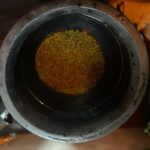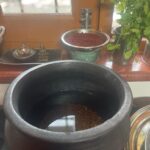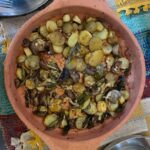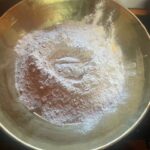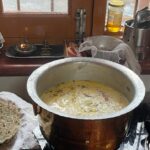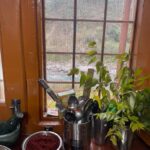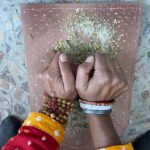Bhairavi Singh introduces the traditional cooking vessels that bring with them energy and nutrition. She shares the cleansing ritual that she follows as Sadhana, in order to keep them safe
The earthen pot has been a cooking vessel for thousands of years. It is a naturally perfect container that absorbs excess water and fire, the two elements most utilized in the transformation of food known as cooking. Maa bhumi is also considered sacred, as she gives us minerals and allows seeds to grow; by cooking in her earthen vessels, we allow her sacred essence to be imparted into our food. Cooking becomes part of a daily sadhana.
My entry into the world of traditional vessels for cooking came from a hankering for old, lost worlds, where flowing with the rhythm of nature was the only way to be. The use of earthen pots thus became for me all about acknowledging the five elements of nature that encompass the entire macrocosm and microcosm through methodical variations, creating everything that is known and unknown. The use of earthen vessels brings into our food -- and thereby into us -- the energy and wisdom of ancient traditions that will withstand the storms of time.

Earthen vessels add many micronutrients into our food that cannot be supplemented through a pill or powder. Slow cooking allows for the retention of flavors and breakdown of the ingredients to release their deepest essence. This allows for nourishment on every level.
The lack of nourishment on every level of dhatus is the major factor in obesity and most other imbalances in the body. Slow cooking in an open vessel makes food easy to digest, protecting the Jatharagni (master digestive fires) from diminishing.
Working with traditional vessels and methods of cooking is also connecting to a time, place, and people that emphasizes sustainability as not just another commercial idea but a way of living in each moment. The care and effort required in the preparation and maintenance of traditional vessels, the time required to learn and understand which kind of vessel is best suited with which dish and in which season is by itself a sadhana and science.
Since most wisdom traditions are fractal by nature, walking deeper into any one part will open doorways to other aspects, all connected yet complete in themselves. We have to look at all journeys into these preparations of food as passage ways rather than destinations or endpoints. This gives us permission to enjoy modern and perhaps more convenient methods of living. As long as the preparations are not harmful to either our inner or outer environment, we can enjoy the timeless wisdom.
We can use vessels made of steel, pre-seasoned earthen pots, or glassware. We can also enjoy the more attention-intensive unseasoned earthen pots or other traditional ware if we are in fine balance. As our senses begin to get clearer as our dinacharya (daily routine) aligns us, we will automatically find ourselves inclined toward using and employing those methods and means of living that are more and more in resonance with nature.
Care and Cleansing Ritual
Earthen Pots
To begin each unique new journey, I purchase each vessel based on the earth being used (the soil of the region), the vendors, the place, and what I am visualizing using the vessel for.
After bringing it home, I first soak the unseasoned pot in clean water for 8-12 hours.
I put it in the sun to dry or find a sunny and warm spot inside. This can take 1-7 days, depending on the altitude, season, climate, and humidity.
Once it dries, I massage both the inside and outside with oil. Usually, I use organic sesame oil or mustard oil, but any cooking oil can be massaged into the new pot based on your usual healthy practices and experience.
I would not advise coconut oil because of its cold potency and tendency to harden in cold weather.
When the oil has soaked in, I fill the clay pot to the top with tandulodaka (rice water rinse) after washing the rice I will be cooking that day. I allow the new pot to sit with the water overnight. The murky water contains some starch and rice husk proteins, but no grains of rice.
After a full overnight soak, I bring that rice water to a slow boil in the new pot using only low heat. Then I turn off the stove and let the vessel rest.
After the pot has cooled, I wash the pot with a gentle cloth or scrubber. I use no detergents or soap unless I know what is in the soap. Personally, I am not ok with the residues of soap that will seep into the pores and eventually into our food, so I avoid soap completely.
Sometimes I use besan if I feel there is excess residue that needs scrubbing.
After the pot has been washed, I allow it to dry, which may take a day or two.
Then I massage with oil again and store in an open, airy place, not in closed cabinets.
This whole process need not be done every time you use the pot, but must be done before the first cooking. If you are using unfinished pots with no glaze, then repeat this process every month or so.
If white mold forms inside the pot, simply fill it with water and baking soda for a few hours and then clean it with warm water and a gentle scrubbing cloth.
If you are a very super-busy person, and cannot invest the time, there are other options today. While it is best to do sadhana by preparing the pot yourself, many vendors I work with now prepare pre-seasoned pots for sale. Even if I get a pre-seasoned pot, however, I will still engage in my saadhana and complete the whole process of soaking in water, drying in the sun, and thoroughly massaging with oil. Only then do I feel it is ready for my cooking.
Sadhana includes remembering that these are breakable pots, much like glassware or china-ceramic in the kitchen. You may want to try cast iron pans and pots if you break too many earthen pots.
Iron pots and pans
Iron pots and pans allowed a level of freedom for cooks, especially if frequent breakage was an issue. Because metal also conveys energy, as well as heat, some special preparation or curing is a must.
For iron pots and pans, I begin with washing the vessel using wood ash. After washing, I put the vessel on low heat for 15 minutes to an hour, depending on the size of the vessel. I then massage the entire pot with sesame oil and store it an upright position to allow the oils to move with gravity into the base.
Special Metal Vessels
Special metal vessels include those made with tin, brass, copper, or bronze.
Often these are finished for use with the art of kalai, a process of coating a layer of tin metal over the alloy surface of copper or brass, known as supashastra in ayurvedic cooking. This tin layer prevents the development of black copper oxides from air exposure or the green toxin copper carbonate that occurs when copper reacts with the moisture in air.
Kalai increases the sadhana needed for a vessel as tin melts at temperatures above 425oF (218.3o C). Because the tin coating also wears away with time and use, kalai is required about every two months if the vessel is used regularly. To protect the coating, one should use wooden spatulas and avoid metal utensils. One must also avoid cooking acidic foods in the vessels.
To clean copper or brass vessels, I strictly avoid harsh scrubbing because it will remove the tin coating and there will be unnecessary effort and expense to getting it coated every time. Every once in a while, to keep the oxidation residues off the vessel, I will massage it with a paste of lemon and salt, or a paste of baking powder. This removes those dangerous chemicals that are produced between metal and air, and metal and water, and keeps the vessel therapeutic.
Why go through all this effort with today's array of convenient vessels? The taste of food cooked in earthen vessels is indescribable. Dahls, vegetables, and grains are richer in flavor and have a robust energy in them. Minerals are slowly imparted into the food as it cooks slowly in these vessels. When people are in a hurry, ancient cookwares remind us to s-l-o-w d-o-w-n and bring sadhana back into our food.


